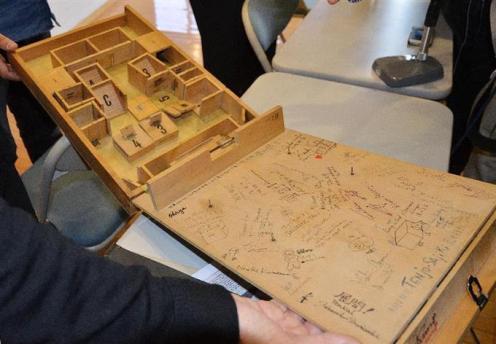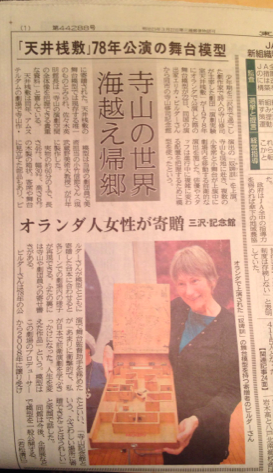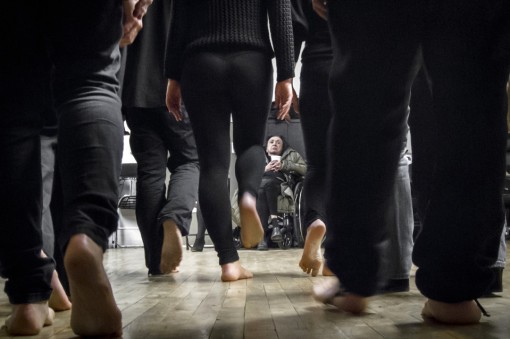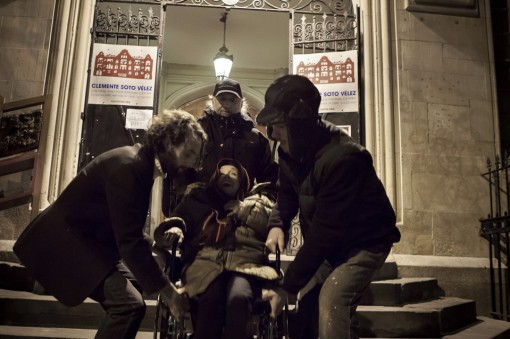THE BOX IS BACK WHERE IT BELONGS
Today is the 32nd anniversary of Terayama Shūji’s (寺山 修司) death. Curiously, it coincides with Memorial Day in The Netherlands- the day preceding Liberation Day where the Dutch observe two minutes of silence from 20:00 to 20:02 to commemorate their country men who have died in wars and peacekeeping missions from the onset of World War II onwards.
Teryama Shūji, playwright, director, poet, filmmaker, innovator, died on May 4th 1983, at age 47.
My connection to his work dates back to late 1977, through a notice posted by the Mickery Theater on the bulletin board of the University of Amsterdam’s Institute of Dramatic Arts. Following up on that notice – that asked for help with the elaborate performances of Cloud Cuckooland, a visit – my life would never be the same again.
Tenjō Sajiki (天井桟敷), an avantgarde theater group from Tokyo, had settled that winter in Amsterdam at the Mickery Theater for a three-month residency to convert Terayama’s Nuhikun (奴婢訓, based on Jonathan Swift’s Directions for Servants) to a moving theater experience that took place in the entire building. Literally moving, and that’s where my role comes in. Perched high up in the rafters of the main theater, I was in charge of directing traffic below on the stage floor, where three curtained boxes mounted on hoovers and moved around by several stage hands transported spectators from scene to scene. Sometimes the audience faced a bare wall or closed curtains, with just audible access to what was going on beyond their 20-person box. This was, of course, in the heydey of audience participation- and manipulation. In the smaller theater upstairs, spectators were treated to the Cloud Cuckooland-part, conceived by Ritsaert ten Cate, only to be acquainted with Nuhikun by the end of the evening, when through a glass pane they could observe the grand finale of Terayama’s play.
What remained of the performance after Nuhikun had toured the rest of The Netherlands, London and Paris (without its hoovering boxes), was a maquette constructed by Tenjō Sajiki’s art director Kotake Nobutake (小竹信節), built of balsa wood inside a suitcase-type box measuring 46 x 30 x 10 cm of thin triplex board. On the day of departure, all cast and crew signed it, rendering it a wonderful time capsule.
Fast forward to September 5, 2008 when Ritsaert ten Cate, founder and director of the Mickery Theater and later Touch Time, dies. I inherit the model of Nuhikun. It is in disrepair. I feel it needs to be in a place where it can be enjoyed by more people than just me.
I get in touch with Terayama’s former wife and Tenjō Sajiki producer Kujō Kyōko (九條今日子), who tells me about her involvement in the establishment of a museum to house the archives of Terayama’s work. It is connected to a memorial, close to where he grew up in Aomori prefecture, in a tranquil and wooded section of Misawa city (of American Airforce Base-fame), overlooking Odanai Pond.
It takes some time to get organised – time in which the model is restored and Kujō-san dies, on 30 April 2014 – but last October, I finally made the pilgrimage to Japan’s deep north to return a piece of Terayama history to its rightful place.
The Terayama Memorial Museum is a wonderfully playful building, where Terayama’s literary, dramatic and cinematographic legacy are kept. Visitors can interact with the material by taking place in a darkened room behind desks where materials are kept, in chronological order and under glass in side drawers, and films are projected onto the desk surface through use of mirrors. In the next room, there is a tableau of Nuhikun set pieces and photographs that illustrate the history of Tenjō Sajiki and Terayama’s life. Manuscripts and further archive materials can be consulted in an adjacent library room.
The memorial overlooking the lake can be reached by walking down a meandering path behind the museum. In short, visiting here means immersion into another world, playful and peaceful at once.
I am treated to an overwhelmingly warm welcome by the museum’s director Eimei Sasaki (佐々木英明) and the Vice Mayor of Misawa, Maita Koichiro, who proceeds to read out loud a Letter of Recognition to me and a gathered audience of members of the press as well as a delegation from City Hall and the local Chamber of Commerce. To my surprise, and great joy, this is a big deal for the city of Misawa.
For a few hours, Mickery’s and Tenjō Sajiki’s illustrious histories are rekindled through storytelling and anecdotes, and Terayama Shūji and Ritsaert ten Cate are in the spotlight once more to illuminate their visionary approach to theater.
And the box is back where it belongs.
Translation DAILY TOHOKU NEWS, Thursday, 23 October 2014
On the 22nd of October, Dutch director Erica Bilder presented to the Terayama Shuji Memorial Hall of Misawa a stage model, dating from the time when the theater company ‘Tenjo-Sajiki’ directed by Terayama Shuji – a poet and a playwright who spent his childhood in Misawa – performed in 1978 in The Netherlands.
This stage model is probably the only one existent for Tenjo-Sajiki, and museum director Eimei Sasaki said with great joy, “It is a most valuable addition to understand the whole of Terayama’s use of performance space.”
In that year, ‘Directions to Servants,’ created and directed by Terayama was presented at the theater in Amsterdam.
Terayama also traveled on tour, and he directed the avant-garde performance [in The Mickery] with many small audiences and stages that move about in the theater .
The actors and staff used this model to understand the arrangement of complex scene changes changes during the performance.
The model was made by Nobutaka Kotake, who was a company member and art director at the time (he is currently a professor at Musashino Art University).
It is a wooden box, and is 1/60 scale of the real thing, length 46cm, width 30cm, and height 10cm. It has parts that simulate the audience and stage, and the model is accompanied by the script that Mrs. Bilder put together, so the original state of each scene in the theater can be recreated.
There are messages of Terayama and members of theater company on the back of its lid.
Mrs.Bilder was assistant of the stage director in the ’78 performance, and she told “I was shocked when I first saw the performance. It gave me a chance to learn about avant-garde theater in Japan. My life was changed by this work.”
She received the model from the producer in 2008, and told with a smile, “I am happy to present this to Terayama Memorial Hall because it belongs here.”
See also:
http://en.wikipedia.org/wiki/Shūji_Terayama
http://en.wikipedia.org/wiki/Tenjō_Sajiki
http://www.theguardian.com/stage/2008/oct/31/ritsaert-ten-cate-obituary
http://press.uchicago.edu/ucp/books/book/distributed/M/bo12379632.html
https://www.terayamaworld.com/museum.html
https://www.terayamaworld.com/about/
http://www.japantimes.co.jp/culture/2015/03/11/stage/going-terayamas-rare-spirit-lives/#.VUcZl6bvjBH













